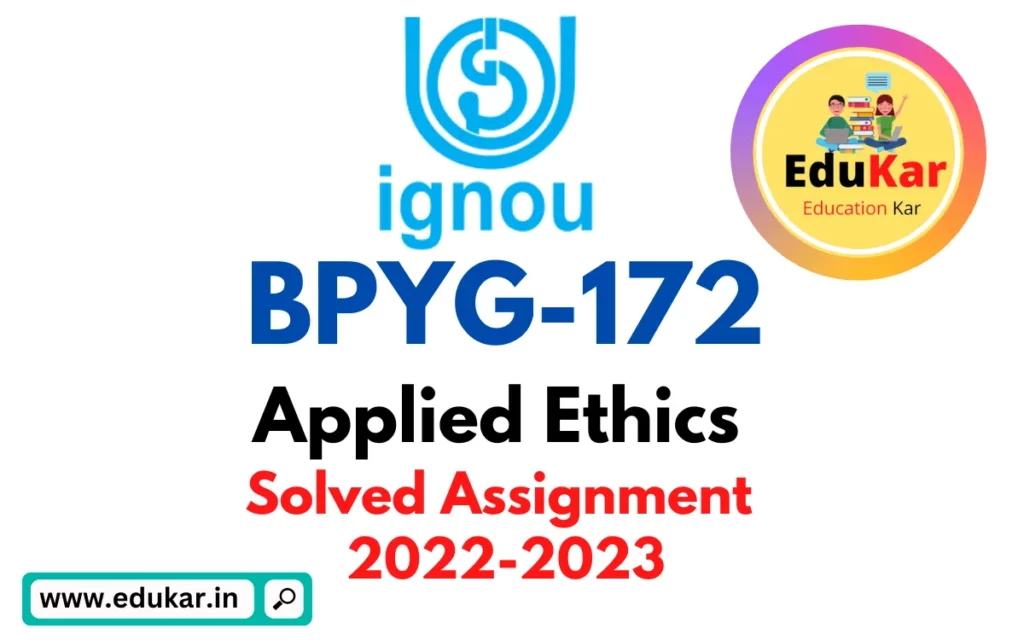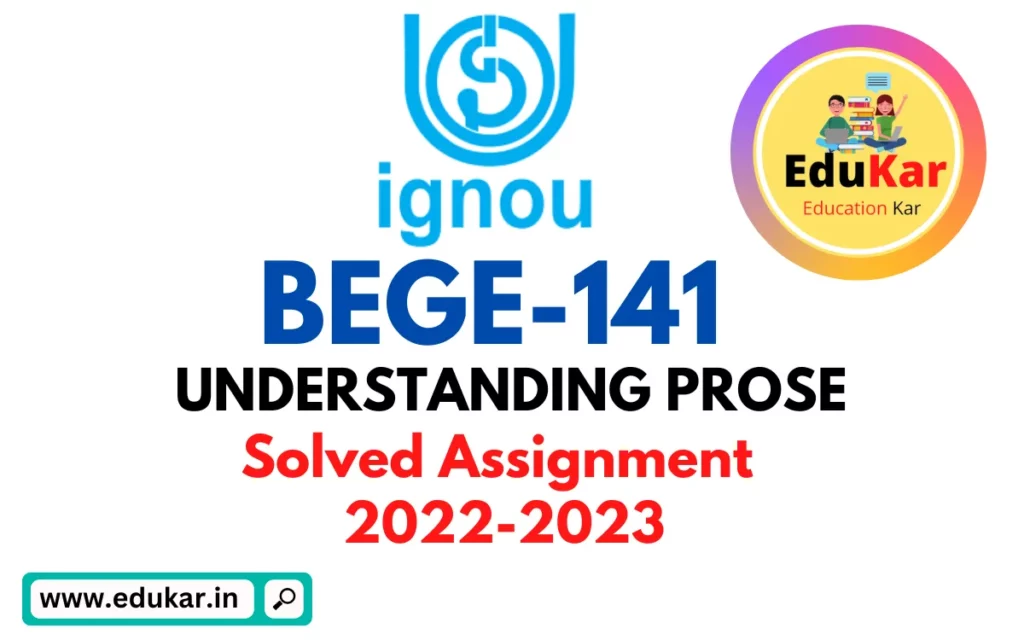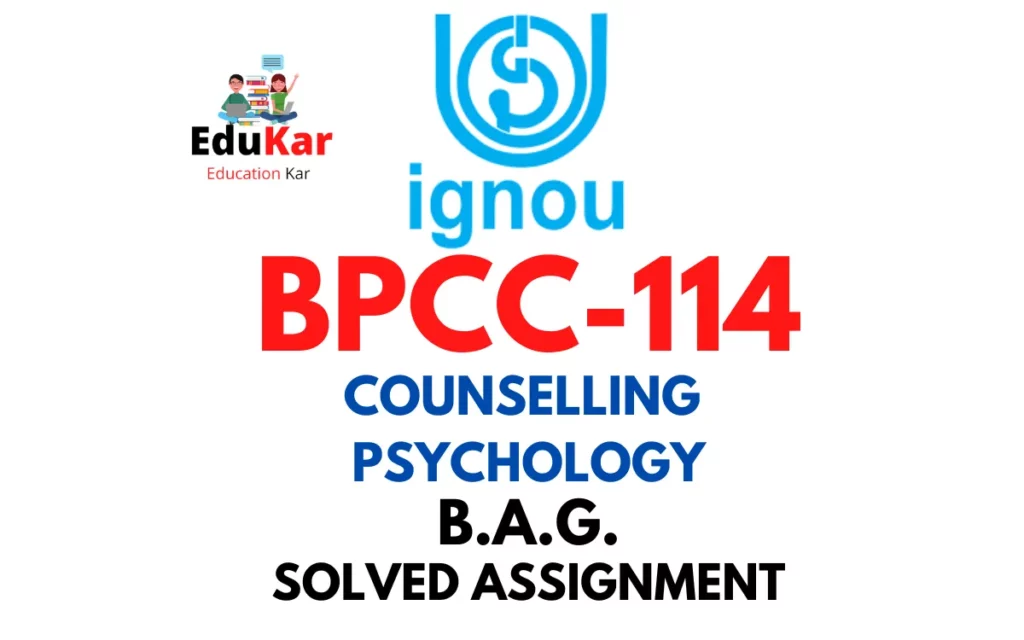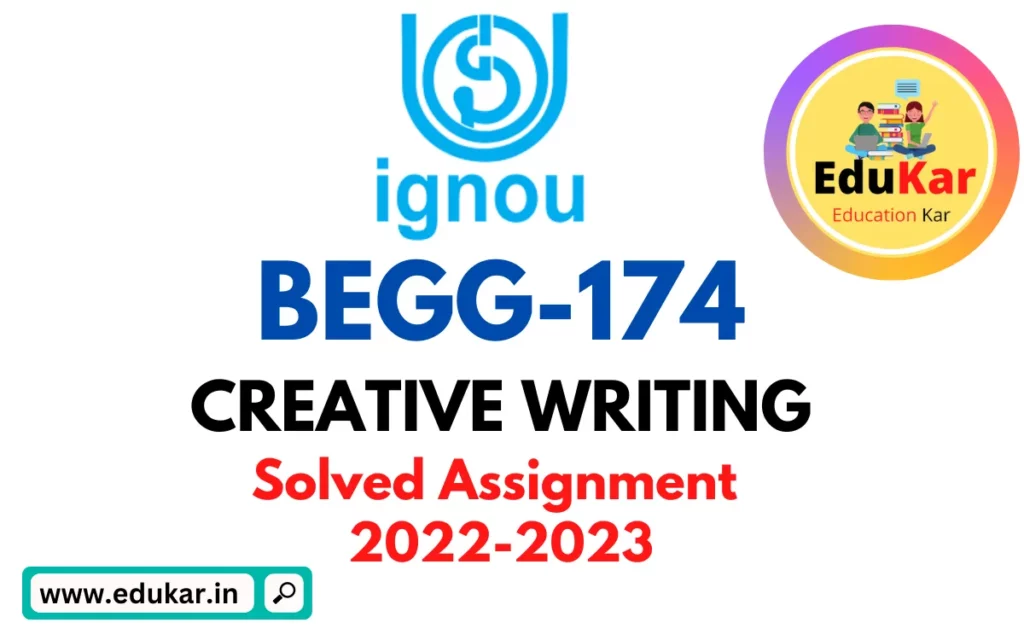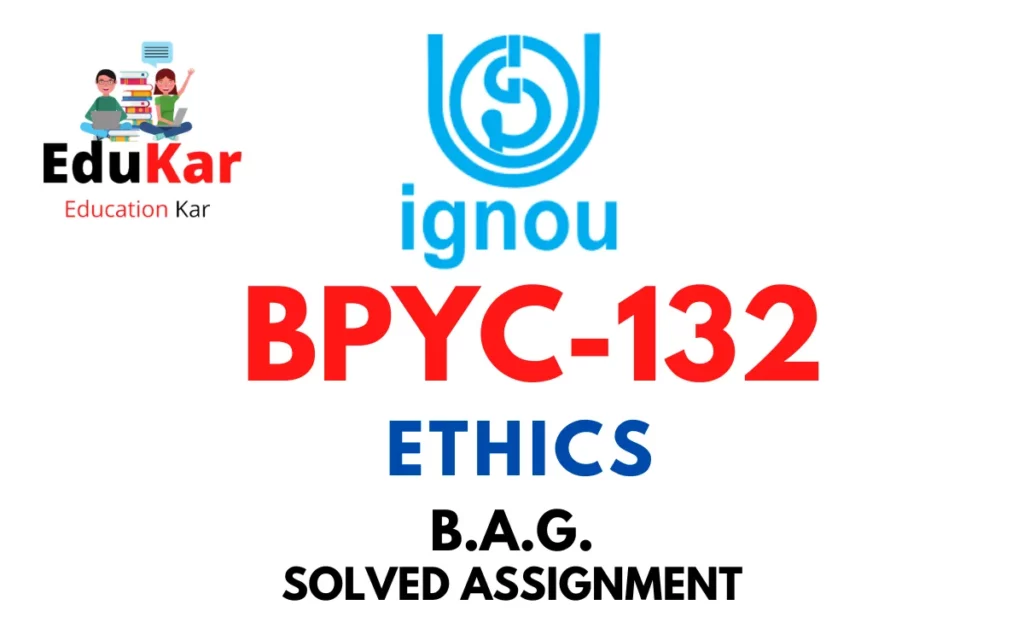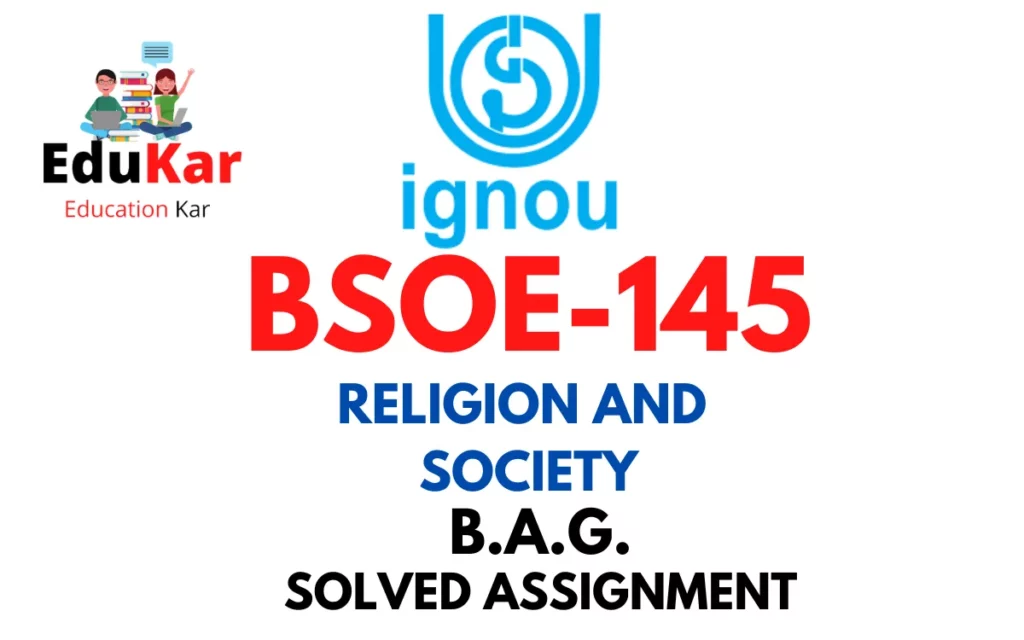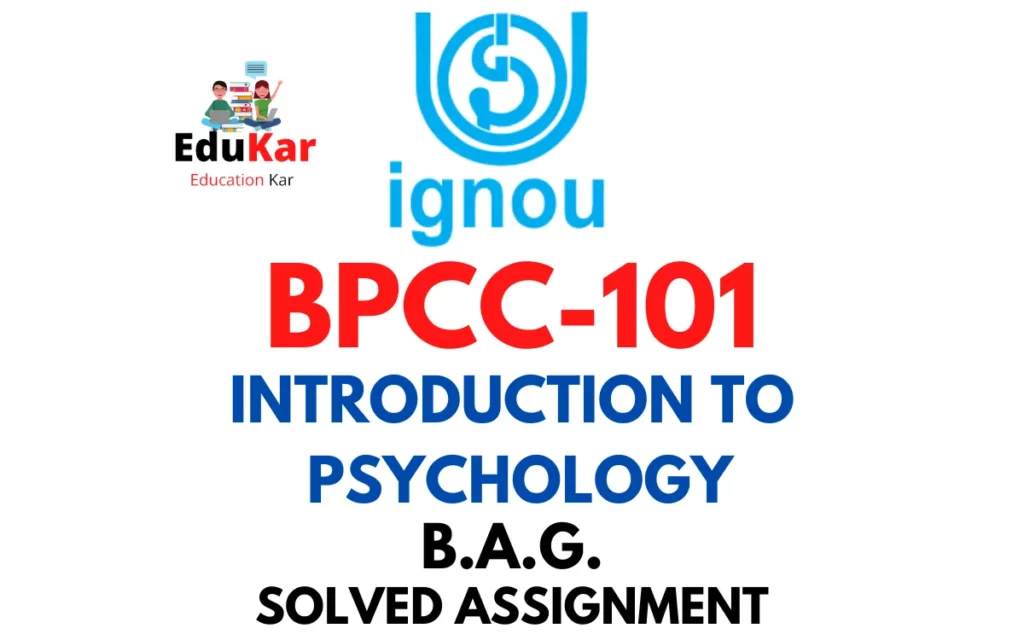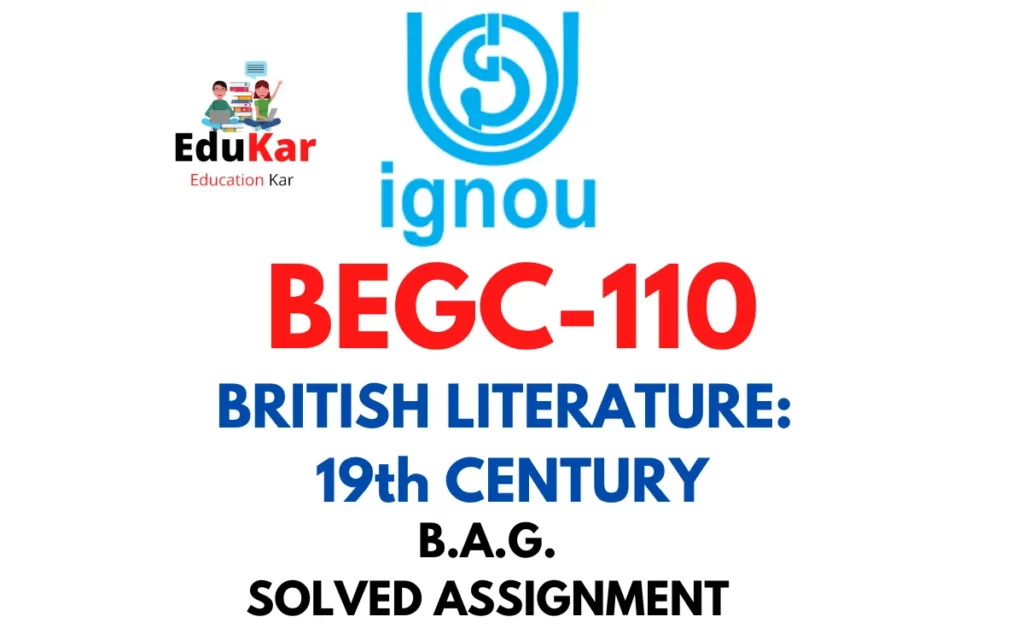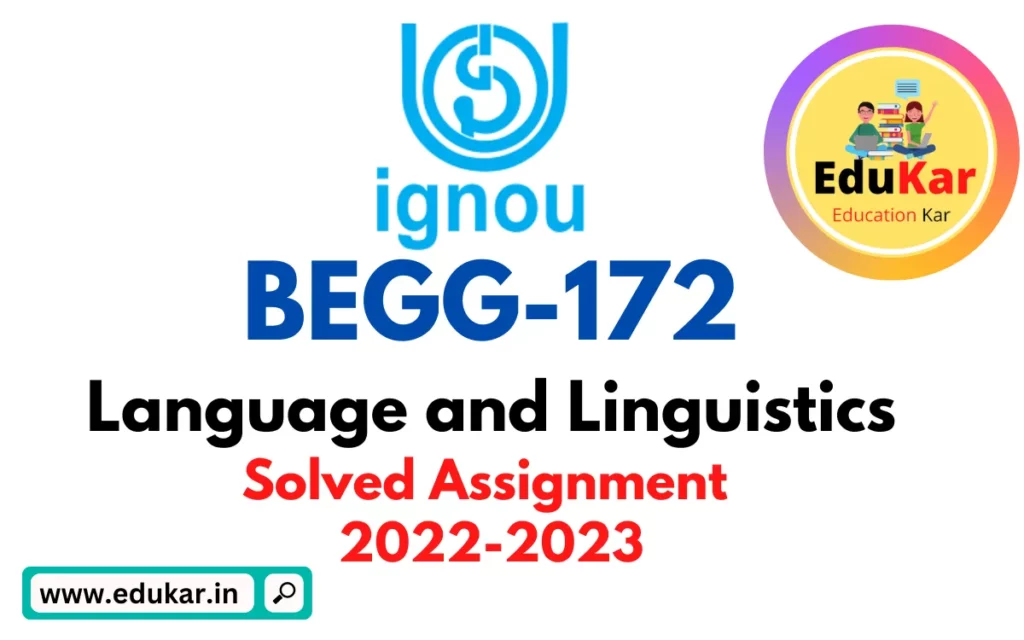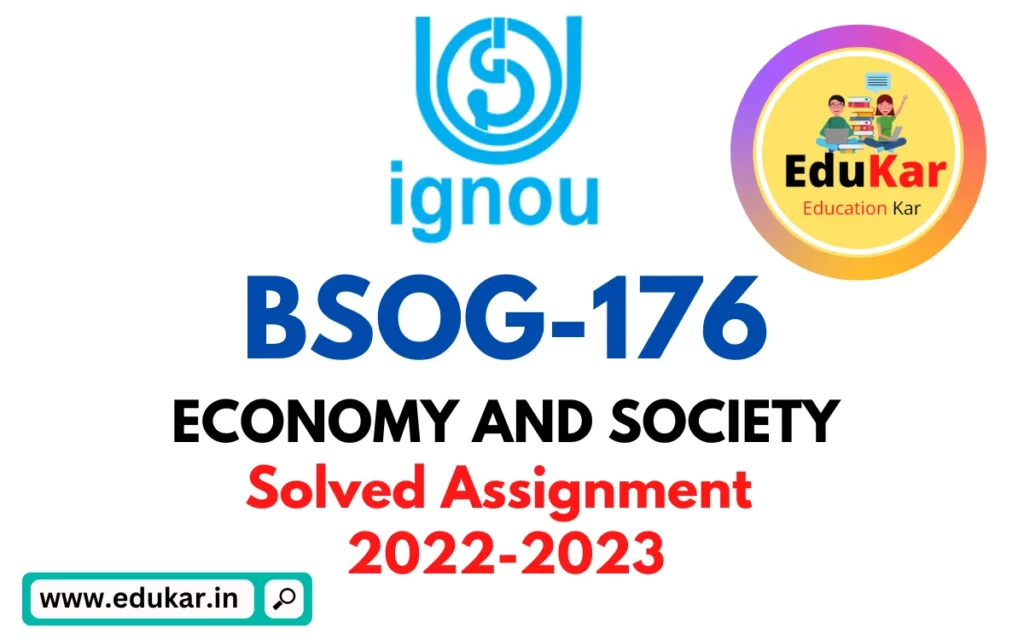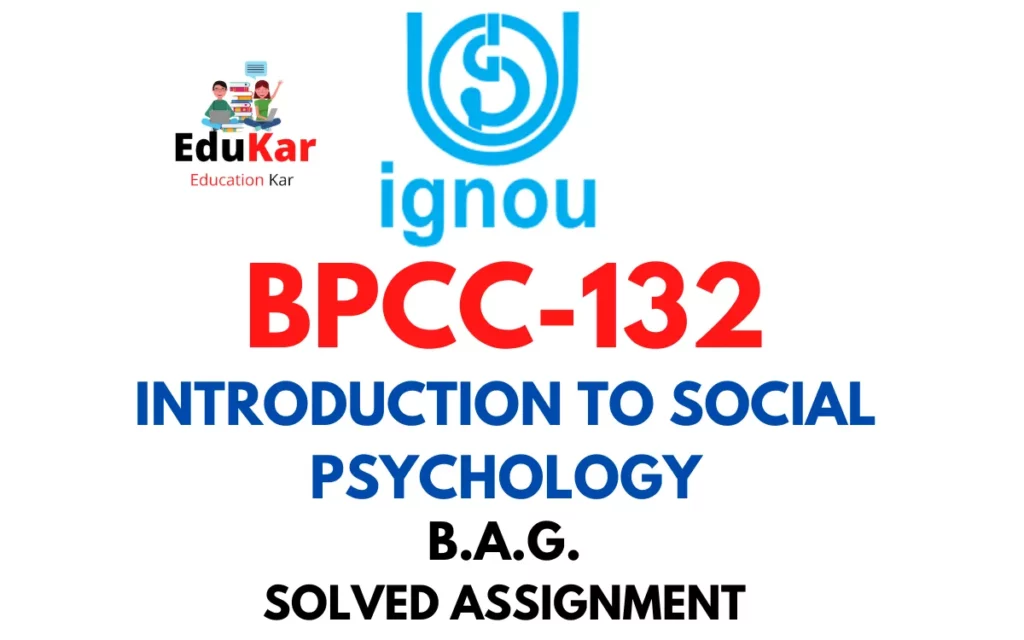Contents
- 1 Section A
- 2 Write short notes/ answer with reference to the context in about 100 words each:
- 3 1.(i) The purpose of Dramatic Art
- 4 (ii) The Sanskrit Epic Tradition
- 5 (iii) “Now I see no other course open but the fourth – punishment. The kings are marching to Kurukshetra to their doom!”
- 6 (iv) … “And from that exalted line/ Of heavenly nymphs was Matavi descended./ A woman of flawlwss birth, of broad shoulders,/ And curly hair, spilling pollen, she was/ Noted for her style of great distinction.”
- 7 Section B
- 8 Answer the following in about 350 words each:
- 9 1. Examine the difference between the Shakuntala in Abhijnana Shakuntala and the Shakuntala episode in the Mahabharata.
- 10 2. Write a critical note on the predicament of Karna in the Mahabharata.
- 11 3. Discuss the significance of the storm in Mrichchhkatika?
- 12 4. Write a detailed note on the idea of justice in Cilappatikaran.
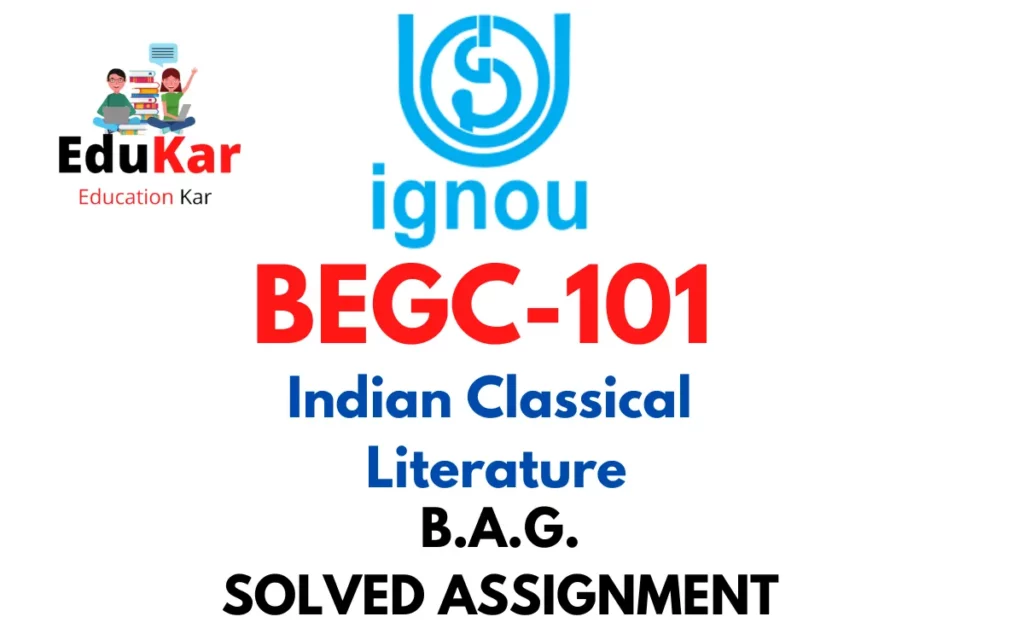
| Title | BEGC-101: IGNOU BAG Solved Assignment 2022-2023 |
| University | IGNOU |
| Degree | Bachelor Degree Programme |
| Course Code | BEGC-101 |
| Course Name | Indian Classical Literature |
| Programme Name | Bachelor of Arts (General) |
| Programme Code | BAG |
| Total Marks | 100 |
| Year | 2022-2023 |
| Language | English |
| Last Date for Submission of Assignment: | For June Examination: 31st April For December Examination: 30th September |
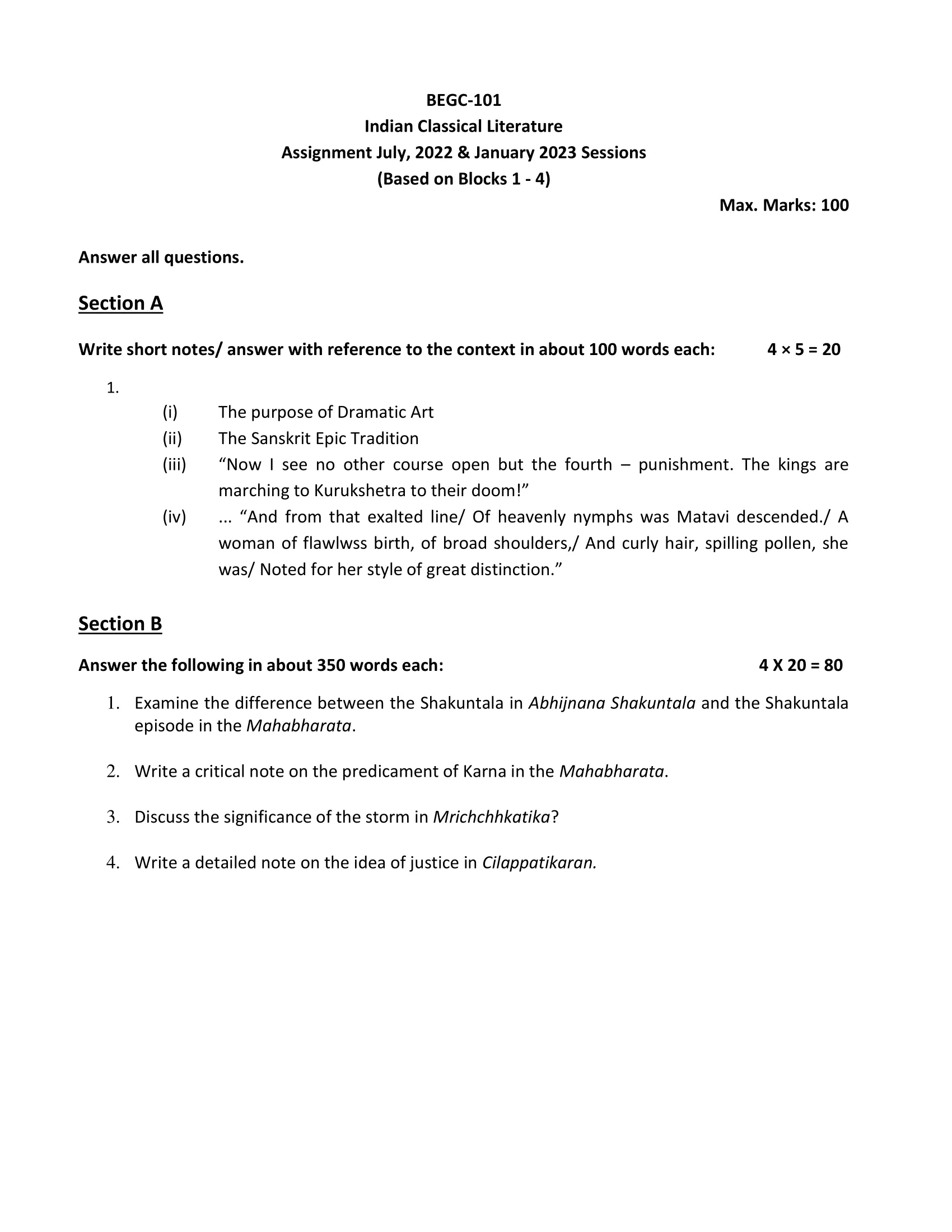
Section A
Write short notes/ answer with reference to the context in about 100 words each:
1.(i) The purpose of Dramatic Art
Ans: Dramatic art is a form of art that involves live performances by actors, where a story is told through dialogue, actions, and emotions. The purpose of dramatic art is to entertain, inform, and educate audiences. It allows individuals to escape their reality and immerse themselves in a world created by the playwright and actors. Additionally, dramatic art is a tool for social commentary and can be used to explore complex societal issues, offer criticism, and challenge the status quo. It can also be a platform for self-expression, allowing individuals to explore their emotions and thoughts through the medium of performance. Overall, the purpose of dramatic art is multifaceted, with its impact on society and the individual often being significant.
(ii) The Sanskrit Epic Tradition
Ans: The Sanskrit epic tradition refers to a body of literature composed in the Sanskrit language, which includes the two great epics of India, the Mahabharata and the Ramayana. These epics are considered as two of the most significant works of literature in Indian history and culture, and they have influenced art, literature, and culture across the Indian subcontinent and beyond.
The Mahabharata is a complex narrative that includes numerous sub-stories and is primarily concerned with the conflict between two sets of cousins, the Kauravas and the Pandavas, over the throne of the kingdom of Hastinapura. The Ramayana, on the other hand, tells the story of the prince Rama and his wife Sita, who is abducted by the demon king Ravana.
Both the Mahabharata and the Ramayana are rich in themes and symbolism, and they explore complex philosophical and ethical issues. They are also sources of inspiration for art, music, and dance, and have been adapted into various forms over the centuries.
The Sanskrit epic tradition is an important part of Indian culture and has played a significant role in shaping the worldview and values of the Indian people.
(iii) “Now I see no other course open but the fourth – punishment. The kings are marching to Kurukshetra to their doom!”
Ans: This statement is a quote from the character Bhishma in the Sanskrit epic Mahabharata, which is one of the most significant works of literature in Indian history and culture.
In this context, Bhishma is referring to the imminent war between the Kauravas and the Pandavas, two sets of cousins who are in a conflict over the throne of the kingdom of Hastinapura. Despite efforts to resolve the conflict peacefully, including negotiations and appeals to reason and duty, the situation has escalated to the point where war seems inevitable.
Bhishma, who is a respected elder and advisor to the Kuru dynasty, recognizes that the war will have devastating consequences for both sides, including the loss of countless lives and the destruction of kingdoms. However, he also believes that the situation has reached a point where punishment is necessary to restore order and justice.
Overall, this quote highlights the complex moral and ethical issues at the heart of the Mahabharata and illustrates the tragic nature of the conflict that unfolds in the epic.
(iv) … “And from that exalted line/ Of heavenly nymphs was Matavi descended./ A woman of flawlwss birth, of broad shoulders,/ And curly hair, spilling pollen, she was/ Noted for her style of great distinction.”
Ans: This quote is from the Sanskrit epic poem, Ramayana. It describes the character Matavi, who is said to be descended from a line of heavenly nymphs. Matavi is portrayed as a woman of flawless birth, with broad shoulders and curly hair that “spills pollen,” which is a poetic way of saying that she has long, beautiful hair that is compared to the fine powder found in flowers.
Matavi is also noted for her style of great distinction, suggesting that she is a woman of great elegance and refinement. The passage shows how the Ramayana uses poetic language and vivid descriptions to create a rich and immersive world that is filled with vibrant characters.
Overall, the quote highlights the importance of lineage and ancestry in Indian culture and mythology, as well as the beauty and grace that are valued in women. It also shows how the Ramayana, like other works of Sanskrit literature, is characterized by its poetic language, vivid imagery, and rich characterization.
Section B
Answer the following in about 350 words each:
1. Examine the difference between the Shakuntala in Abhijnana Shakuntala and the Shakuntala episode in the Mahabharata.
Ans: Shakuntala is a character in Indian mythology who has been depicted in various texts and forms of art over the centuries. Two prominent depictions of Shakuntala are in the play Abhijnana Shakuntala by Kalidasa and the Shakuntala episode in the Mahabharata. While both these works feature Shakuntala as a central character, there are significant differences between the two depictions.
Abhijnana Shakuntala is a play written by Kalidasa in the 5th century CE. It tells the story of Shakuntala, the daughter of the sage Vishwamitra and the apsara Menaka. Shakuntala falls in love with King Dushyanta and marries him in secret. However, the king is cursed to forget about Shakuntala, and she is forced to live in isolation until the curse is lifted. The play explores themes of love, fate, and the consequences of human actions.
On the other hand, the Shakuntala episode in the Mahabharata is a part of the epic poem that tells the story of the Kuru dynasty. In this episode, Shakuntala is the daughter of the sage Kanva and is raised in the forest. King Dushyanta meets her in the forest and marries her in a ceremony without witnesses. However, when Dushyanta has to leave, he gives Shakuntala a ring as a token of his love and promises to return for her. When she later goes to the king’s court to join him, she is rejected because she cannot produce the ring, which she has lost. But later, the ring is found inside a fish’s belly, and Shakuntala is accepted back by the king.
One of the main differences between the two depictions is the nature of Shakuntala’s character. In Abhijnana Shakuntala, Shakuntala is portrayed as a sensitive, emotional character who is deeply affected by the curse that makes the king forget about her. She is shown as a loving wife who longs to be reunited with her husband. In contrast, the Shakuntala of the Mahabharata is a more practical and strong-willed character who fights to be recognized by the king and to reclaim her rightful place in his court.
Another difference is the focus on the romantic relationship between Shakuntala and King Dushyanta. In Abhijnana Shakuntala, the play centers around the love story between the two characters and the challenges they face in being together. In the Shakuntala episode of the Mahabharata, the focus is more on the social and political implications of their marriage, including the rejection of Shakuntala by the king’s court and her eventual reinstatement.
2. Write a critical note on the predicament of Karna in the Mahabharata.
Ans: Karna is one of the most complex and tragic characters in the Mahabharata, the epic poem that tells the story of the Kuru dynasty. Karna is the son of Kunti and the sun god Surya, but he is raised by a low-caste charioteer. He faces numerous challenges throughout the story, including rejection by his mother and society, struggles with his identity, and ultimately, his loyalty to Duryodhana, the Kaurava prince.
Karna’s predicament begins with his birth. Kunti, who is unmarried, gives birth to him and abandons him in a basket on a river. He is found and raised by Adhiratha, a charioteer, and his wife, Radha. Despite being raised in poverty and being rejected by his mother, Karna grows up to be a skilled warrior and a friend of Duryodhana.
One of the central themes of Karna’s predicament is his struggle with his identity. He is aware of his noble birth and heritage, but his low-caste upbringing and his loyalty to Duryodhana prevent him from fully embracing his identity. He is often ridiculed and discriminated against by members of the Kuru court, who see him as a low-caste outsider. Despite this, Karna is a skilled warrior and earns the respect of many, including his enemies.
Another aspect of Karna’s predicament is his relationship with Duryodhana. Despite knowing that Duryodhana is on the wrong side of the war, Karna remains loyal to him and fights for the Kauravas. This loyalty ultimately leads to his downfall, as he is killed in battle by Arjuna, one of the Pandavas. Karna’s death is tragic, as he is killed by his own brother, whom he had never met before the war.
Karna’s predicament can be seen as a commentary on the social and political structures of ancient India. His low-caste birth and his struggle to be accepted by society highlight the discrimination and prejudice that existed in ancient Indian society. His loyalty to Duryodhana, despite knowing that he is on the wrong side of the war, can be seen as a critique of blind loyalty and the destructive consequences it can have.
3. Discuss the significance of the storm in Mrichchhkatika?
Ans: The storm is a significant symbol in the ancient Indian play Mrichchhakatika (The Little Clay Cart) written by Shudraka. It is used as a dramatic device that not only adds to the narrative but also carries a deeper meaning that serves to reinforce the themes and motifs of the play.
The storm serves as a pivotal point in the play, marking a significant turning point in the plot. It occurs in Act IV when Vasantasena, a courtesan, is held captive in the house of her abductor, the merchant Samsthanaka. In the midst of the storm, Charudatta, a nobleman who has fallen on hard times, takes shelter in the same house. The storm is used to symbolize the chaos and turmoil in the lives of the characters and also serves as a catalyst for the events that follow.
The storm is significant in the play as it creates a sense of urgency and tension, heightening the dramatic tension and contributing to the climactic events of the play. It is used to convey a sense of danger, both physical and emotional, that the characters are facing. The storm is also used to signify the unpredictable nature of life and the inevitability of change.
The storm also serves as a metaphor for the social and political unrest in ancient India, which is reflected in the play’s themes of corruption and injustice. The storm is used to convey the tumultuous nature of the times, the upheaval of social norms and the struggle for power.
Additionally, the storm serves to symbolize the rebirth and renewal that follows the destruction. This is seen in the aftermath of the storm when the characters experience a sense of clarity and renewal, leading to a change in their fortunes. The storm thus serves as a metaphor for the cycle of life, death, and rebirth that is central to Indian philosophy.
4. Write a detailed note on the idea of justice in Cilappatikaran.
Ans: Cilappatikaram, also known as the Tale of an Anklet, is a Tamil epic poem written by the poet Ilango Adigal in the 5th century CE. The poem tells the story of Kovalan and Kannagi, a married couple who face a series of tragedies and injustices that lead to their ultimate downfall.
The theme of justice is a central concern in the poem. Throughout the narrative, we see how the characters struggle to attain justice in the face of social, political, and economic inequality. The poem is a powerful commentary on the nature of justice, and the challenges of achieving it in a world that is often unjust.
At the heart of the poem is the idea of dharma, which refers to the universal law that governs human conduct and morality. Dharma is often equated with justice, as it provides a framework for ethical and moral behavior that is based on fairness, compassion, and righteousness.
The poem portrays the pursuit of justice as a fundamental human desire that is both personal and collective. Kovalan and Kannagi seek justice for themselves, as they are wronged by those in power, but they also seek justice for their community, which is suffering under the yoke of oppression and corruption.
Throughout the poem, we see how the pursuit of justice is often complicated by issues of class, gender, and power. Kovalan, as a member of the merchant class, is often subject to discrimination and exploitation by those in power, while Kannagi, as a woman, faces even greater challenges in seeking justice. However, both characters are determined to fight for their rights and the rights of others, regardless of the obstacles they face.
The poem also highlights the importance of compassion and empathy in the pursuit of justice. Kovalan and Kannagi are not only seeking justice for themselves, but they are also motivated by a desire to help others who are suffering. They are guided by a deep sense of empathy and compassion, which enables them to see beyond their own personal grievances and to work towards a more just and equitable society.
How to Download BEGC-101 Solved Assignment?
You can download it from the www.edukar.in, they have a big database for all the IGNOU solved assignments.
Is the BEGC-101 Solved Assignment Free?
Yes this is absolutely free to download the solved assignment from www.edukar.in
What is the last submission date for BEGC-101 Solved Assignment?
For June Examination: 31st April, For December Examination: 30th October

![[Solved Assignment] BPCS 185-DEVELOPING EMOTIONAL COMPETENCE (IGNOU-BAG) 2022-2023 [Solved Assignment] BPCS 185-DEVELOPING EMOTIONAL COMPETENCE (IGNOU-BAG) 2022-2023](https://edukar.in/wp-content/plugins/contextual-related-posts/default.png)
